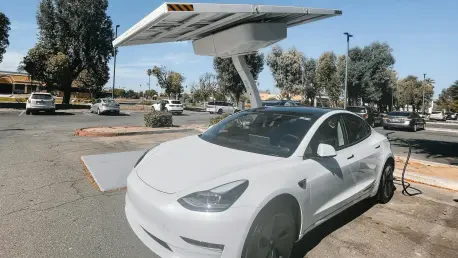The push towards sustainable logistics in the UK is hitting a formidable barrier as the adoption of electric heavy goods vehicles (eHGVs) struggles to gain momentum, casting doubt on the nation’s ability to meet the Zero Emissions Vehicle (ZEV) mandate targets set for 2035 and 2040. With a deadline looming for HGVs under 26 tonnes to go zero-emission by 2035, and heavier vehicles by 2040, the stark reality is that less than 1% of new eHGV registrations in the second quarter of this year are zero-emission. This sluggish progress stands in sharp contrast to the electrification of cars and vans, revealing a deep-rooted issue: the severe lack of charging infrastructure tailored for these large vehicles. The energy demands of eHGVs, often requiring batteries exceeding 700 kWh, call for ultra-fast chargers and robust grid connections—resources that remain scarce across the country. This gap not only threatens environmental goals but also undermines confidence in the technology, leaving the logistics sector at a critical crossroads.
The Scale of the Challenge
Energy Demands and Infrastructure Shortfalls
The immense energy requirements of eHGVs present a daunting hurdle in the transition to zero-emission logistics. Unlike smaller electric vehicles, these heavy-duty trucks often rely on batteries with capacities over 700 kWh to haul goods over long distances, demanding a level of power that far exceeds typical EV charging setups. Ultra-fast chargers, capable of replenishing these massive batteries during brief operational windows like driver breaks or loading times, are essential. However, such technology is sparsely available, with most existing infrastructure geared toward lighter vehicles. The grid connections needed to support these high-power chargers are also lacking, as many depots and public locations require significant electrical upgrades to handle the load. This shortfall creates a bottleneck, stalling the widespread adoption of eHGVs and leaving fleet operators grappling with the practicality of switching to electric models without reliable charging solutions in place.
Beyond the technical challenges, the scale of infrastructure needed to support eHGVs is staggering and currently unattainable with the existing framework. Building a network of high-power chargers requires not just equipment but also strategic planning to ensure coverage across key routes and hubs. Depots, often seen as the starting point for electrification, face constraints in space and electrical capacity, making upgrades costly and time-intensive. Meanwhile, the broader road network remains largely untouched by eHGV-specific charging solutions. The absence of a cohesive plan to address these energy demands means that even willing operators find themselves unable to commit to electric fleets, as the risk of being stranded without power looms large. Until this infrastructure gap is bridged with targeted investments and innovations, the vision of a zero-emission HGV fleet risks remaining out of reach, jeopardizing critical environmental targets.
Public Charging Gaps
The absence of public charging facilities for eHGVs, particularly at truck stops and motorway service stations, is a glaring obstacle for long-haul operations. Unlike depot-based charging, which can serve vehicles during downtime, public charging points are vital for drivers covering extensive routes where returning to a central hub isn’t feasible. Currently, such facilities are virtually non-existent, leaving operators with no viable options to recharge during journeys. This gap directly impacts the feasibility of adopting eHGVs for long-distance transport, as fleet managers cannot guarantee uptime without access to power along major highways. The lack of public infrastructure not only slows adoption but also erodes trust in the technology, as the logistics sector relies heavily on seamless operations to meet tight delivery schedules.
Compounding the issue, the development of public charging hubs for eHGVs faces significant logistical and financial barriers that deter progress. Establishing these facilities involves navigating complex land ownership issues, securing planning permissions, and funding the high costs of installation and grid connections. Unlike the car and van charging markets, where private investment has gained traction due to visible demand, the eHGV sector struggles to attract similar backing. Charge point operators hesitate to commit without a guaranteed user base, while fleet operators hold off on purchases without assured charging access. This deadlock stifles the creation of a network that could support long-haul eHGVs, underscoring the urgent need for a coordinated approach to break the cycle and ensure that public charging becomes a reality for the industry.
Policy and Funding Limitations
Depot-Centric Focus
Government policies aimed at supporting eHGV electrification have so far taken a narrow approach, primarily focusing on depot-based charging solutions, which fail to address the broader needs of the sector. Initiatives like the Depot Charging Scheme are a step forward, offering funding to install chargers at central hubs where vehicles return for downtime. However, the scale of this support is woefully inadequate, with projections suggesting it will cover only about 200 HGV chargers nationwide. This figure pales in comparison to the hundreds of locations required to create a functional network for the logistics industry. By prioritizing depots, policymakers overlook the critical role of on-route charging for long-haul operations, leaving a significant portion of the HGV fleet without viable solutions and hampering the transition to zero-emission vehicles.
Moreover, the depot-centric focus reveals a disconnect between policy design and the operational realities of the logistics sector. Many depots, especially older facilities, lack the electrical capacity or space to accommodate high-power chargers, necessitating costly upgrades that can take years to complete. Even when chargers are installed, they only serve vehicles that return to base regularly, excluding a large segment of the industry that operates over extended distances. This limited scope of support fails to instill confidence among fleet operators, who need assurance that their vehicles can recharge anywhere along their routes. Without a more comprehensive strategy that extends beyond depots to include public infrastructure, the government risks falling short of its ZEV mandate targets, as the majority of eHGV needs remain unaddressed.
Investment Hesitation
A persistent “chicken and egg” dilemma plagues the eHGV sector, where the lack of charging infrastructure deters fleet adoption, and low adoption rates discourage investment in charging facilities. Fleet operators are reluctant to invest in electric vehicles without a reliable network of chargers, especially for long-distance routes where the risk of running out of power is a real concern. This hesitation creates a market with minimal demand, making it difficult for charge point operators to justify the high costs of building specialized eHGV charging hubs. Unlike the more mature markets for electric cars and vans, where private funding has fueled infrastructure growth, the eHGV space struggles to attract similar financial backing, perpetuating a cycle of stagnation that slows progress toward electrification goals.
Breaking this deadlock requires a catalyst to spur both demand and investment, yet current funding mechanisms fall short of providing the necessary push. Private investors remain cautious due to uncertainties around residual values of eHGVs and the long-term viability of the market without government guarantees. Meanwhile, public funding initiatives are limited in scope, failing to offer the scale or certainty needed to draw in additional capital. This hesitation on both sides leaves the industry in limbo, unable to move forward without a clear signal of commitment from policymakers to support infrastructure development. Until a robust framework emerges to bridge this gap, the mutual dependency between fleet adoption and charging availability will continue to hinder the electrification of heavy goods transport in the UK.
Operational and Industry Dynamics
Unique Needs of eHGVs
The operational requirements of eHGVs set them apart from smaller electric vehicles, creating distinct challenges in designing suitable charging infrastructure. Due to their large dimensions and limited maneuverability, these vehicles need dedicated spaces that can accommodate their size while ensuring safety during charging. Standard EV charging stations, built primarily for cars and vans, are ill-suited for HGVs, as they lack the necessary layout and power capacity to handle such heavy-duty demands. Additionally, safety considerations in charging yards—such as preventing collisions and managing high-voltage equipment—add layers of complexity to infrastructure planning. These unique needs mean that solutions cannot simply be adapted from existing networks, requiring purpose-built facilities tailored specifically for eHGVs to enable their integration into the logistics sector.
Further complicating the issue, the specialized infrastructure for eHGVs demands significant investment and coordination that current systems are not equipped to provide. Building dedicated charging hubs involves not only higher costs but also strategic location planning to ensure they align with major transport corridors and logistical hubs. The time-sensitive nature of freight operations adds pressure, as chargers must deliver rapid turnarounds to minimize downtime. Without addressing these specific requirements, the industry faces a persistent barrier to adoption, as operators cannot rely on generic EV infrastructure to meet their needs. A focused effort to develop eHGV-specific solutions, supported by both public and private stakeholders, is essential to overcome these operational hurdles and pave the way for a sustainable transition in heavy goods transport.
Collaborative Efforts and Their Limits
Amid the challenges, collaborative initiatives within the logistics industry offer a glimmer of hope, though their impact remains constrained by scale. Projects like eFreight 2030, supported by nearly £50 million in government funding and aiming to catalyze £500 million in private investment, seek to establish an initial network of 32 charging locations. This effort reflects a willingness among stakeholders—including fleet operators, manufacturers, and infrastructure providers—to tackle the charging gap collectively. However, while such projects mark a positive step, they fall short of the hundreds of sites needed to support widespread eHGV adoption across the UK. The limited scope highlights a critical mismatch between current ambitions and the actual requirements of a fully electrified HGV fleet, underscoring the need for broader action to amplify these early efforts.
Even with collaborative momentum, systemic barriers continue to limit the effectiveness of these initiatives, revealing the depth of the challenge. Charge point operators face persistent issues such as complex planning processes, disputes over land ownership, and long lead times for securing megawatt-scale grid connections. Although recent reforms have reduced wait times for some grid projects, the scale required for eHGV charging often stretches into years, delaying critical infrastructure rollout. These obstacles dampen the impact of industry partnerships, as the pace of implementation struggles to keep up with the urgency of the ZEV mandate timelines. To move beyond incremental progress, a more robust, government-led strategy must complement these collaborative efforts, addressing systemic hurdles and providing the certainty needed to scale up infrastructure to meet national demands.
Path Forward for Sustainable Logistics
Reflecting on the barriers that have stalled eHGV adoption, it becomes evident that actionable steps are crucial to overcoming the charging infrastructure deficit and driving progress in the logistics sector. Significant strides are needed to expand beyond depot-focused solutions, with a concerted push to develop public charging hubs at truck stops and along major highways. Policymakers must prioritize funding and strategic planning to establish hundreds of dedicated eHGV charging locations, ensuring accessibility for both short and long-haul operations. Collaborative projects like eFreight 2030 serve as a foundation, but their limited scope demands amplification through broader government intervention to attract private investment. Streamlining grid connection processes and resolving planning challenges emerge as vital actions to accelerate infrastructure deployment. By addressing these systemic gaps, the UK can position itself to break the cycle of hesitation, fostering confidence among fleet operators and paving the way for a truly sustainable logistics future.









